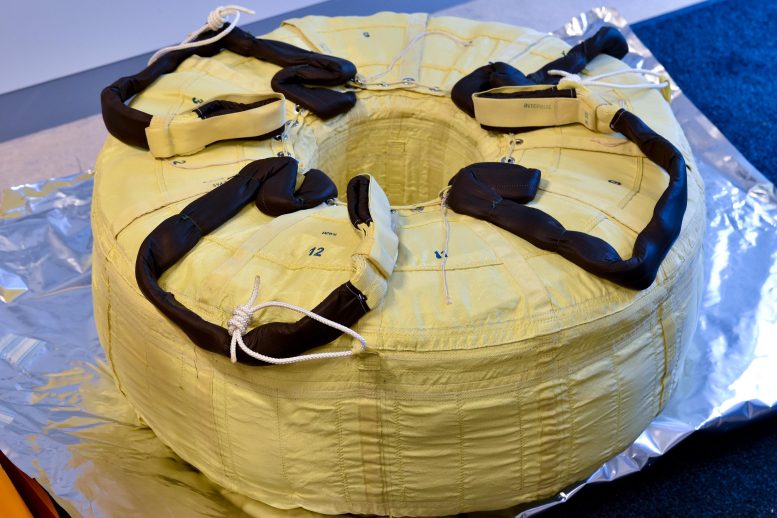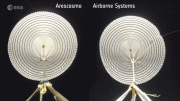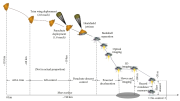
This 35-m (115-ft) diameter parachute is a copy of the largest-ever parachute to open on Mars. Credit: ESA–P. Horváth
Carefully wrapped inside this donut-shaped bag is a 35-m (115-ft) diameter parachute that will endure a frenzied six-minute dive into the Martian atmosphere.
This qualification model is a copy of the largest-ever parachute to open on the Red Planet when it flies on the ExoMars 2022 mission – and it is at least 10,000 times cleaner than your smartphone.
The 64 kg (141 lb) parachute, made mostly of nylon and Kevlar fabrics, has been thoroughly sterilized to reduce its level of contamination for planetary protection. One of the main goals of ExoMars is to search for signs of life on the Red Planet, so any microbes hitchhiking on its ride from Earth would interfere with the investigation and could trigger a false positive – what scientists call ‘forward contamination.’
The potential existence of past and perhaps even present life on Mars requires rigorous sterilization. Scientists want to be sure that the instruments on the ExoMars rover Rosalind Franklin, only detect signs of indigenous life, but protecting the martian environment from ourselves is equally as important. A planetary protection policy by the Committee on Space Research (COSPAR) details all requirements, in compliance with the United Nations Outer Space Treaty.
The parachute was heated in an oven at 125°C (257°F) for several days to kill any microbes. The oven is part of ESA’s Life, Physical Sciences and Life Support Laboratory, a state-of-the-art facility in the Netherlands. The Laboratory has also cleaned ExoMars instruments and subsystems, but this second stage parachute is the largest item to be sterilized.
The dry heat sterilizer is in the ‘ISO Class 1’ cleanroom, one of the cleanest places in Europe. All air passes through a two-stage filter ensuring less than 10 dust particles no larger than 10 millionth of a meter, or less than the size of the coronavirus.
People working on the ExoMars hardware are the main biohazard. Every day, each of us sheds millions of skin particles. Everyone entering the chamber has to gown up more rigorously than a surgeon before passing through an air shower to remove any remaining contaminants. Watch how to dress to avoid being a ‘bioburden’ in the latest ExoMars vlog (below).
The parachute will next prove itself in high-altitude drop tests. The whole parachute assembly system, mounted onto a drop test vehicle, will be lifted to an altitude of nearly 30 km (19 mi) by a helium balloon. The vehicle will free-fall until the test parachute sequence starts in pressure conditions similar to diving into the Martian atmosphere.
The dates of these tests have been postponed due to the coronavirus outbreak, and a new window of opportunity for testing is pending confirmation.









Be the first to comment on "Rigorous Sterilization for Planetary Protection"